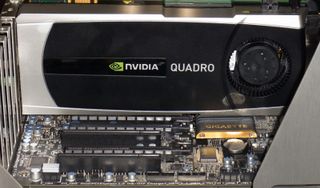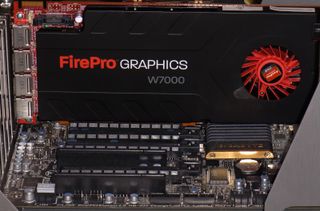How Well Do Workstation Graphics Cards Play Games?
We all know that gaming and workstation graphics cards employ the same hardware, differentiated by slight tweaks, drivers, and validation. We also know desktop cards usually perform awfully in professional apps. Does the reverse hold true as well?
FirePro W9000 And W7000 Do Well; FirePro W8000 Disappoints
Workstation graphics cards are optimized for stability, reliability, and a class of software most often used by professionals to make money. Their alacrity in games varies wildly.
On one hand, it’s interesting to see how the AMD FirePro W7000 beats the company's gaming-oriented Radeon HD 7870 in some tests and finishes slightly behind it overall. Given the W7000’s lower clock rate and Catalyst Pro drivers that aren’t optimized for gaming, we would have expected it to fall in line right behind the Radeon HD 7850.
On the other hand, the FirePro W8000 massively underperforms in our game-based benchmarks. It doesn’t just get beaten by AMD's less expensive FirePro W7000, but also by the higher-end Nvidia Quadro cards with their previous-generation Fermi GPUs.

The FirePro W7000 sells for about $770. That’s a great price for a powerful workstation card that can handle gaming when your work day is over. Performance in pro apps based completely on DirectX is similarly good. We took a quick look at this board using Maya 2013 and AutoCAD, and it has no trouble competing against more expensive products. If you don’t have to have CUDA support for your workload or an exclusive certification for a specific application, then the FirePro W7000 is certainly worth consideration.

Another of the FirePro W7000's strong points is its power consumption. This is Pitcairn at its best. The card manages to stay well below AMD's specified 150 W ceiling during normal operation, and in fact falls below 100 W much of the time in games. This is why I personally recommend it to anyone who doesn’t need to use Nvidia-exclusive applications.
Bottom Line
We often get folks wondering how desktop-oriented apps handle professional workloads, and today's experiment turned that question around. Now we know that workstation graphics cards are better for gaming than gaming cards are in professional tasks. Case in point: The FirePro W9000 nearly manages to keep up with AMD's Radeon HD 7970. The slightly lower performance of a workstation card in the latest shooter is a lot easier to live with than the massively lower performance you get from a GeForce or Radeon in a professional application.
Once again, the lesson here is that, in the workstation graphics segment, you don’t pay that massive premium for better hardware so much as you pay for the drivers and validation. This isn't something that should be held against AMD or Nvidia, even though we know they sell the same silicon into cards that cost a fraction as much. Driver development and optimization takes a lot of expensive time and work. Games are fun and all, but when you step aboard that new 787, you need to trust that the workstations responsible for every piece of it were 100% accurate.
Current page: FirePro W9000 And W7000 Do Well; FirePro W8000 Disappoints
Prev Page Cumulative Performance IndexStay On the Cutting Edge: Get the Tom's Hardware Newsletter
Get Tom's Hardware's best news and in-depth reviews, straight to your inbox.

Redditor allegedly purchased two Intel Arc B570 GPUs at Micro Center days before the official launch — the CPU couldn't recognize the GPUs due to the lack of driver support

Spanish retailer lists RX 9070 and RX 9070 XT GPUs, though the prices might be mere placeholders — RX 9070 for $912 and RX 9070 XT for $1,097
-
MyUsername2 Are these cards so expensive because fewer people need to buy them, or do they really have that much more tech in them?Reply -
ipwn3r456 Umm, why not the newest Quadro K5000 is being benchmarked, but the newest FirePro W9000 is being tested here?Reply -
velocityg4 MyUsername2Are these cards so expensive because fewer people need to buy them, or do they really have that much more tech in them?Probably the former plus they can get away with charging more as business customers need them.Reply
Same with Enterprise hard drives. They are pretty much the same as regular hard drives. The only real difference is how they deal with data errors. The consumer drive will try to correct the error and recover the data causing the drive to not respond for a while and the RAID controller to thing it went bad potentially taking down the array when trying to rebuild. An Enterprise drive just notes the error and keeps chugging along asking the array for the corrupted data.
Now while the Enterprise hard drive is little more than a firmware change, making their price appalling. At least these workstation cards actually have some different chips and design requiring their own manufacturing equipment. So their higher price is more justified as they have to make changes to their line for a relatively small number of cards.
If they had a demand as high as the gaming cards their prices would probably be pretty close to their gaming counterpart. I'm sort of surprised one of them hasn't just unified their gaming and workstation line and dominate the workstation market. -
FormatC ReplyUmm, why not the newest Quadro K5000 is being benchmarked, but the newest FirePro W9000 is being tested here?
Ask Nvidia and take a look in the NDA- Try to buy one ;)
-
anxiousinfusion So its Toms suggesting that enthusiasts who want bleeding edge performance start building gaming machines with the W9000 cards?Reply -
moneymoneymoney @anxiousinfusion I would say that they're saying if you want professional performance in CAD & 3D Rendering software but also game on the same machine then these cards can do just that. Instead of buying two machines (one for work and one for gaming).Reply -
guvnaguy Do companies use these cards for any sort of video game design? If so I could see why they need optimized for both applications.Reply
Just goes to show how under-utilized the high-end gaming hardware is. If that kind of driver tweaking went into gaming cards, you could probably max out Metro 2033 on a 8800GTX, eh?
-
rmpumper I had a laptop with quadro fx3600m 3 years ago and from personal experience know that it was identical as the 8800GTm at gaming.Reply